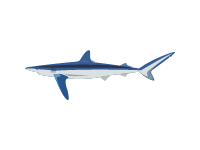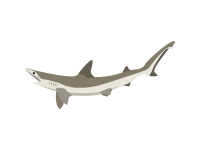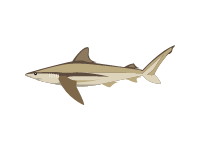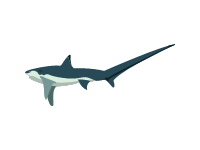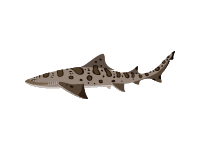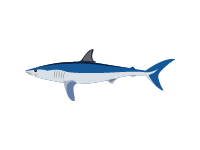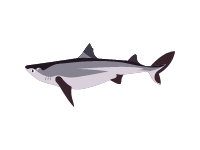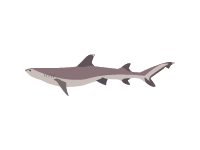Blue sharks are curious, open-ocean predators that live throughout the global ocean, from the tropics to cold temperate waters. They spend most of their lives far from the coast and are truly a pelagic species. The common name comes from the blue color of the skin, unique among the sharks. Blue sharks are light-bodied with long pectoral fins. Like many other sharks, blue sharks are countershaded: the top of the body is deep blue, lighter on the sides, and the underside is white. The male blue shark commonly grows to 1.82 to 2.82 m (6.0 to 9.3 ft) at maturity, whereas the larger females commonly grow to 2.2 to 3.3 m (7.2 to 10.8 ft) at maturity. Large specimens can grow to 3.8 m (12 ft) long. Occasionally, an outsized blue shark is reported, with one widely printed claim of a length of 6.1 m (20 ft), but no shark even approaching this size has been scientifically documented. Large specimens can grow to 3.8 m (12 ft) long. Occasionally, an outsized blue shark is reported, with one widely printed claim of a length of 6.1 m (20 ft), but no shark even approaching this size has been scientifically documented. Occasionally, a female in excess of 3 m (9.8 ft) will weigh over 204 kg (450 lb). The heaviest reported weight for the species was 391 kg (862 lb).The blue shark is also ectothermic and it has a unique sense of smell. he blue shark is an oceanic and epipelagic shark found worldwide in deep temperate and tropical waters from the surface to about 350 m (1,150 ft). In temperate seas it may approach shore, where it can be observed by divers; while in tropical waters, it inhabits greater depths. It lives as far north as Norway and as far south as Chile. Blue sharks are found off the coasts of every continent, except Antarctica. Its greatest Pacific concentrations occur between 20° and 50° North, but with strong seasonal fluctuations. In the tropics, it spreads evenly between 20° N and 20° S. It prefers water temperatures between 12 and 20 °C (54–68 °F), but can be seen in water ranging from 7 to 25 °C (45–77 °F).Records from the Atlantic show a regular clockwise migration within the prevailing currents. Squid are important prey for blue sharks, but their diet includes other invertebrates, such as cuttlefish and pelagic octopuses, as well as lobster, shrimp, crab, a large number of bony fishes, small sharks, mammalian carrion and occasional sea birds. Whale and porpoise blubber and meat have been retrieved from the stomachs of captured specimens and they are known to take cod from trawl nets.Sharks have been observed and documented working together as a 'pack' to herd prey into a concentrated group from which they can easily feed. Blue sharks may eat tuna, which have been observed taking advantage of the herding behaviour to opportunistically feed on escaping prey. The observed herding behaviour was undisturbed by different species of shark in the vicinity that normally would pursue the common prey. The blue shark can swim at fast speeds, allowing it to catch up with prey easily. Its triangular teeth allow it to easily catch hold of slippery prey. Young and smaller individuals may be eaten by larger sharks, such as the great white shark and the tiger shark. Killer whales have been reported to hunt blue sharks. This shark may host several species of parasites. For example, the blue shark is the definitive host of the tetraphyllidean tapeworm, Pelichnibothrium speciosum. It becomes infected by eating intermediate hosts, probably opah and/or longnose lancetfish.
Northern elephant seals have been observed to feed on blue sharks.
